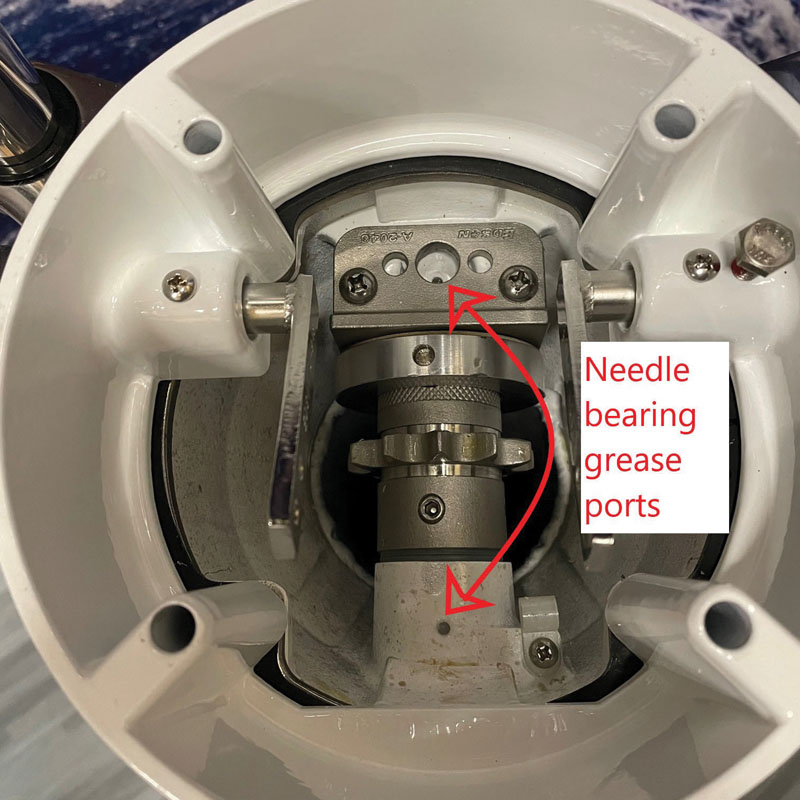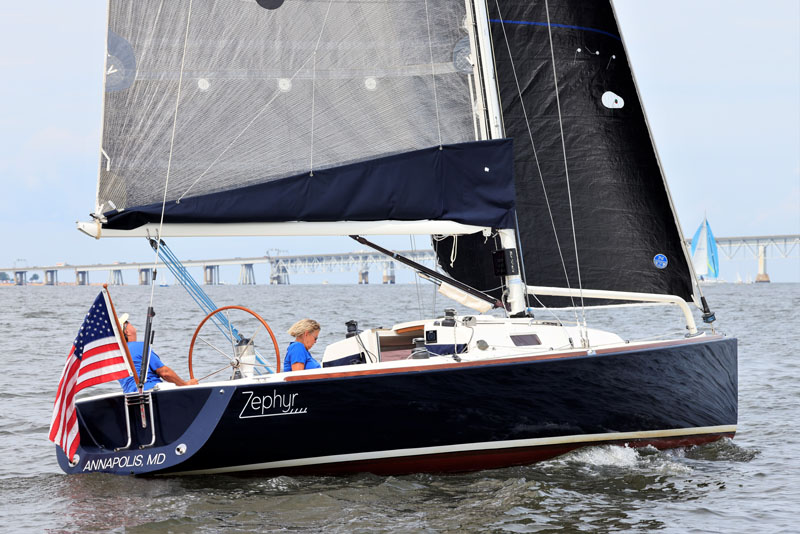Minimize the risk of steering troubles
Once you have a sailboat with chain and wire steering that’s in good operating condition, a few simple maintenance procedures will maximize the lifespan of all your gear and minimize the risk of any mid-passage or mid-afternoon Bay sail steering troubles.

The basic service is lubing the steering chain and cables and the steerer needle bearings. Videos explaining this process are available on the Edson website under the “Support” tab, but it’s a simple process. Simply pop the compass (or top cover if there’s no compass) off your pedestal to expose the steering chain and turn it all the way to one side. Using Edson ChainCare+ (best), Boeshield T-9 (better), or 30 weight oil (good, but messy), coat the chain while turning the wheel from side to side.
While the compass is still off, lube the needle bearings fore and aft on the steerer shaft. The small holes atop the shaft supports provide an entryway for grease. Edson recommends SuperLube-brand Teflon-based grease, which plays nicely with the plastic cages on the needle bearings, is waterproof, and is an excellent lube. The opening on the small half-ounce tube makes a great applicator for this purpose.
With the inside of the pedestal maintenance done, it’s time to head below to dress (or coat) the steering cables. First, pass a cotton ball along the length of the cable, between your fingers. The cotton will snag on any burrs in the cable (saving our fingers from doing that job), which indicate trouble with the cable. Assuming no snags, take your ChainCare+ or Boeshield (don’t use 30w oil here) and a rag, and spray the cable from the pedestal idler all the way back to the quadrant or radial.
Many boats have conduit systems, which follow all the same steps except that you will grease the cables inside the conduit using SuperLube. Turn the wheel hard to one side and use the exposed cable to “suck” lube into the conduit. Use only synthetic grease in the conduit, as petroleum-based lubes will eat the conduit’s plastic lining.

While at the quadrant/radial...
While at the quadrant/radial, have someone turn the wheel from hard over to hard over and make sure that the quadrant or radial engages the rudder stop mechanism before the wheel stops turning. If the wheel stops turning before the rudder stop is engaged, it means either the rudder needs to be stopped earlier, or the chain is installed off center.
If the quadrant/radial hits the stop on one side but not the other, the chain is off center. Loosen the cable tension completely at the tension eyes, and move the chain one link on the sprocket away from the direction where the stop doesn’t engage (if the rudder stop doesn’t engage in a turn to port, move the chain one link to starboard on the sprocket at the wheel). Test to see if that solves the issue, and if needed continue moving the chain link by link until the rudder stop engages in both directions. If the rudder stop doesn’t engage in either direction, you can pad the glassed-in stop blocks or shorten the tether, whichever is relevant for your boat.
Having checked the chain symmetry, spray a shot of ChainCare+ or Boeshield on the threads of each cable tensioner eye, and tension the steering cables. Make sure to balance the adjuster eyes as you tighten—a few turns on one side and a few on the other. This keeps the chain centered on the sprocket and ensures you maintain complete range of steering motion. Correct tension is key. Too much and you will cause binding and wear in the system, while not enough tension causes steering play and opens the risk of having the cable jump a sheave. With the wheel turned hard to one side, the “lazy” cable should just barely begin to droop. Once the cables are correctly tightened, put the second nut on each adjuster eye and torque it down hard. These prevent the cable eyes from loosening with use.
With regular care, chain, wire, and conduit have a 10-year service life in typical use in salt water and longer in fresh water. Needle bearings typically last 20 years in salt and fresh, again assuming regular greasing. Year-round or heavier use will require more frequent service and replacement. For the typical Bay sailor, where the water isn’t particularly saline, an annual service is usually sufficient unless you sail all the time. If you spend the winter cruising south, the service intervals get much shorter, so you’ll run through this list every two months or so.
Keeping a good inspection and maintenance schedule is key to ensuring the performance and safety that great steering provides.
by Dave Kirkpatrick of Edson International
Questions? Email Dave




